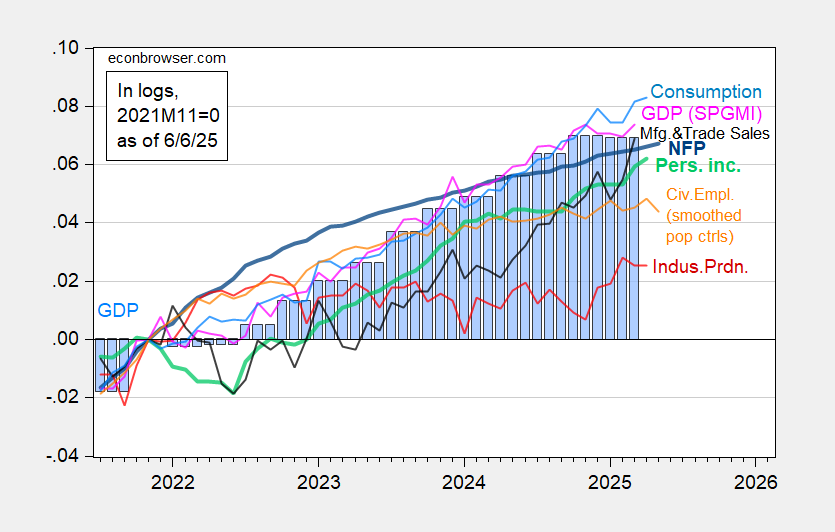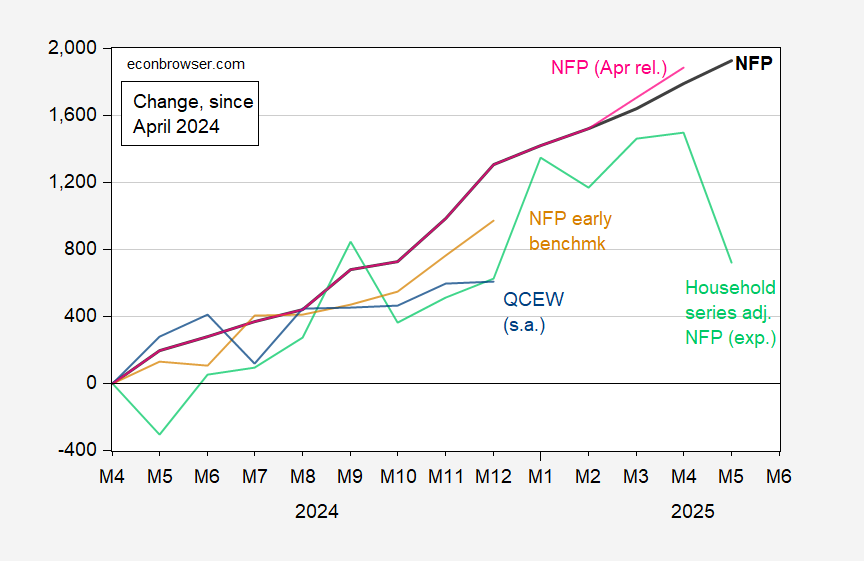+139K vs +126K Bloomberg consensus; private NFP +140K vs +110K. Manufacturing employment down 8K vs -1K consensus. But durable manufacturing production workers down -12K.
Overall, business cycle indicators followed by the NBER’s Business Cycle Dating Committee seem fairly solid
Figure 1: Nonfarm Payroll incl benchmark revision employment from CES (bold blue), civilian employment using smoothed population controls (orange), industrial production (red), personal income excluding current transfers in Ch.2017$ (bold light green), manufacturing and trade sales in Ch.2017$ (black), consumption in Ch.2017$ (light blue), and monthly GDP in Ch.2017$ (pink), GDP (blue bars), all log normalized to 2021M11=0. 2025Q1 GDP is second release. Source: BLS via FRED, Federal Reserve, BEA, S&P Global Market Insights (nee Macroeconomic Advisers, IHS Markit) (5/1/2025 release), and author’s calculations.
Civilian employment is down, but given the relatively low precision of this series, low weight should be placed on it.
On the other hand, NFP growth has been revised down in previous months. Here’s a picture of various measures of this indicator.
Figure 2: Change since 2024M04, in Nonfarm Payroll Employment (bold black), April NFP (pink), household series adjusted to NFP concept (light green), NFP early benchmark (tan), and QCEW seasonally adjusted by author over 2021M01-2024M12 using X13 (blue), all in 000’s.
Two things to remark on: both the Philadelphia Fed’s early benchmark and QCEW suggest slower growth (QCEW more so; the early benchmark is based on QCEW figures through Q3, so the shown QCEW series is more up-to-date).
What do we know about the manufacturing sector, which we anticipate will be heavily affected by tariffs and tariff uncertainty?
Figure 3: Manufacturing production (blue), value added in 2017$ (red), production and nonsupervisory worker employment (tan), hours (light green) all in logs, 2024M04=0; and capacity utilization (NAICS), % (black, right scale). Aggregate hours of production workers calculated by multiplying average weekly hours by employees. Source: Federal Reserve, BEA, BLS, and author’s calculations.
The impact of “Liberation Day” is not too apparent in Figure 3. Focus on employment (where we have May data) and on durables manufacturing, as in Figure 4.
Figure 4: BLS manufacturing employment (brown), ADP manufacturing employment (light blue), BLS manufacturing employment, production and nonsupervisory workers (tan), hours (light green), BLS durable manufacturing employment, production and nonsupervisory workers (purple), and durable nonmanufacturing hours (pink), all in logs, 2024M04=0. Aggregate hours of production workers calculated by multiplying average weekly hours by employees. Source: BLS, ADP, and author’s calculations.




One little adjustment to the numbers. Any federal employee who took the buy-out is still counted as employed. They are no longer working for the government – for us. That’s about 75,000 workers. There are other categories, such as furloughs, that also skew the job count upward.
This is not really a cyclical indicator, not reflective of economic health, at the national level. Local jurisdictions have had the their budgets clobbered, their housing markets dented, but what they lose, others gain.
It’s government services that are lost through early retirements due to buy-outs. Nothing mysterious about that.
Economist Stephen Miran, chairman of Trump’s Council of Economic Advisers, goes full on nationalist racist as he crows that all of the job gains since Trump’s inauguration has gone to “native born Americans.”
Miran: Underneath the surface, there are some really promising details. All of the job gains were native born Americans — all of them.”
This is so sad… Miran obviously meant “All of the job LOSSES were native born Americans — all of them.” It’s a shame that he’s so anxious to please his master that he can’t get his facts straight. The “native born” and “non-native born” employment data series come from the household survey, which clocked a 696,000 job loss in May. Native born workers accounted for 444,000 of those losses:
https://fred.stlouisfed.org/graph/?g=1JtxR
At best, Miran can claim that of the job losses suffered so far in the felon-in-chief’s second term, none of them are due to native born workers:
https://fred.stlouisfed.org/graph/?g=1Jty6
However, if May’s count, the first post-Liberation-Day tally of native born worker employment, hints at things to come, look out below.
Biden, on the other hand, could claim gains in total employment, native and non-native employment during his presidency:
https://fred.stlouisfed.org/graph/?g=1Jty9
Economist Stephen Miran, chairman of Trump’s Council of Economic Advisers, goes full on racist nationalism on CNBC as he crows that all of the job gains since Trump’s inauguration have gone to “native born Americans.”
Miran: Underneath the surface, there are some really promising details. All of the job gains were native born Americans — all of them!”
I am going to stray off topic and continue my criticism of musk. president musk and chairman trump have been gutting the government for months. all in the name of DOGE. nasa is in the crosshairs and going to get crippled soon. musk knows best, right? just let spacex take over nasa work, because it is better, right? in todays dollars, nasa spent around $6 billion dollars and sent multiple crews to the moon and back. only lost one partial rocket. musk and spacex have sent 9 starships off the launch pad. not one has been successful. and only one actually reached space, but then immediately failed. starship capabilities have been scaled back significantly from what was originally promised-almost to the point of not being useful at all from a payload perspective. spacex has spent $10 billion dollars and so far cannot successfully launch and land a rocket, much less leave the atmosphere. nasa went to the moon, landed, and returned at half the price. and you really think musk and trump have the intelligence to enact doge cuts and improve the country? then I got a bridge to sell you.
Musk is in the rocket business, has a degree in engineering and all that. He is not in the government business, doesn’t have a degree in economics, public affairs, health policy, any of the sciences, accounting, education, elder care, medicine, you name it.
Given Elon’s record in the space business, where he has some claim to relevant knowledge, who the hell would put him in charge of whatever-the-hell DOGE is? It’s an impeachable offense, I tell ya.
Some people call Elon Musk both the Henry Ford and Werner von Braun of our century, which is appropriate since they all are Nazi collaborators.
By the way, Musk does not have a degree in engineering. He has degrees in economics and physics. It is pretty well known that Gwyeen Shotwell at SpaceX specifically keeps Musk away from the real engineers to keep him from screwing things up. The same at Tesla. He has no real talent for engineering. He is very talented at getting government welfare for his projects, without which he would be a failure.
Note that Musk was not a founder of Tesla not matter what he claims. He bought into the previously established company with $5 million. Around the same time the Obama administration put $500 million into the company without which it never could have developed its first commercially successful car, the Model S. So the taxpayers invested 100 times as much in Tesla as Musk.